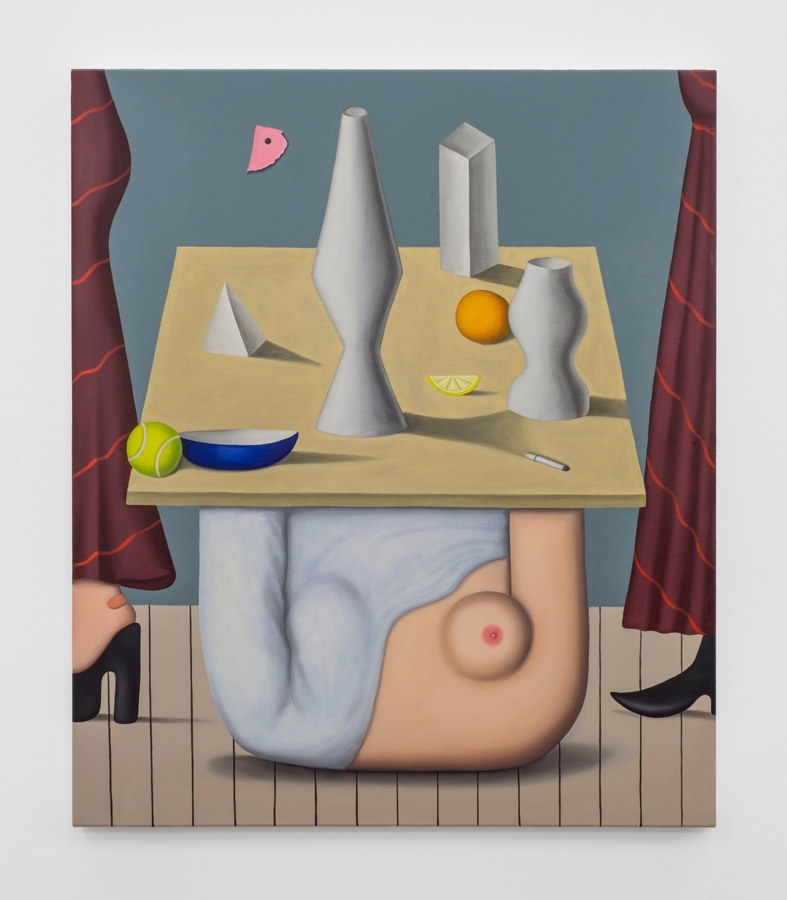In spite (or perhaps because) of feminism’s current fashion ‘moment’, gracing the front cover of Elle magazine (December 2014, ‘The Feminism Issue’), being touted as ‘a good thing’ by actor Benedict Cumberbatch and British deputy prime minister Nick Clegg, and generally being bandied around like this season’s colour, it still remains difficult – deeply unfashionable, in fact – to employ feminism as a critical perspective if you veer towards scepticism with regard to an artwork’s potentially dubious gendered representation. It’s almost as though, in questioning the exhaustive and incessant reduction of the female body to a trope, you’re being too obvious, a bit critically clumsy, a bit boring. So Jonathan Gardner’s eight candy-coloured oil paintings, over half of which depict nude or semiclothed, blank-faced female ‘types’ or disembodied breasts and legs, might be, as the press release tells us, ‘representing a style of painting as opposed to representing a subject’, but it is nevertheless women’s bodies (not animals, men, food or landscape) that are both style and subject matter here. Apparently, then, the fact that he focuses so frequently on nudes influenced by canonical art history, from neoclassicism to (particularly) Surrealism and Pop (Ingres, Magritte, Lindner and Currin are all mentioned in the PR) is incidental. Really? What year is it again?
Allen Jones recently said of his 1960s mannequin / furniture sculptures that he ‘was not making an object out of women – women were the subject, the object was a sculpture’ (he also said that dressing his mannequins in fetish gear ‘enhanced their sculptural form’, a point that was made evident with almost pneumatic clarity). Gardner seems to be attempting to construct a similar equation, explicitly so in the case of Table Torso (all works 2014). These aren’t women, they’re paintings of women, and what’s more, the fact that these are nude women is neither here nor there, as he (press release again) ‘places no greater importance on this part of the paintings than on the wallpaper, towels, tables and books he includes’. Apparently, then, ‘these “objects” [inverted commas as per the press release] exist as blank slates upon which he can insert [where are the inverted commas?!] his own idiosyncracies, interests and references’ (cue Sid James-style laughter). ‘The figures’, it goes on to say, ‘are void of personality or any recognizable trait, functioning in the same way as a brushmark or abstract motif.’ But they don’t, and with these words, Gardner is damned by his own press release.
If these paintings are not strategically arch, kitsch or parodic in some way, if they’re not even (in their repetition) a lascivious wink at the oversexualisation of women in art history, then what are they doing?
If these paintings are not strategically arch, kitsch or parodic in some way, if they’re not even (in their repetition) a lascivious wink at the oversexualisation of women in art history, then what are they doing? If, as has been suggested, the symbolism of the works is removed from the context of the work or movements these paintings cite. The works seem to be composites of existing images and symbols, but without the creative or critical free association of, for instance, Sigmar Polke. Instead we have a compendium of Magritte’s faces, breasts and torsos (Inner Living, Daisy), Hockney’s LA colour, line and geometric design (Zig Zag), Balthus’s figural composition and languid pose, the blank expression, outline and stillness of Léger’s women (Women in White) and Picasso’s demoiselles in Superga trainers (Superga). This ‘tissue of quotations’ is just that – imagery lifted and placed into new paintings.
What exactly is Gardner’s point, other than a bit of standard copying and aura stripping? The paintings certainly seem devoid of the critical potential of classic appropriation art. The artist is ‘keen to offer an openness in interpretation’, as opposed, presumably, to making some kind of critical statement, but to my mind, this sounds like a get-out clause. He might have said: ‘With regard to the tits and arses, people, it’s over to you. I absolve myself of accountability.’ These paintings are by a contemporary US artist who must be aware that the female nude, especially the female nude painted by a man – is a problematic and loaded genre. As such, throwing us the old ‘network of meanings’ and ‘open-ended interpretation’ shtick just won’t cut it. It’s 2014 FFS!
This article was first published in the January & February 2015 issue.
